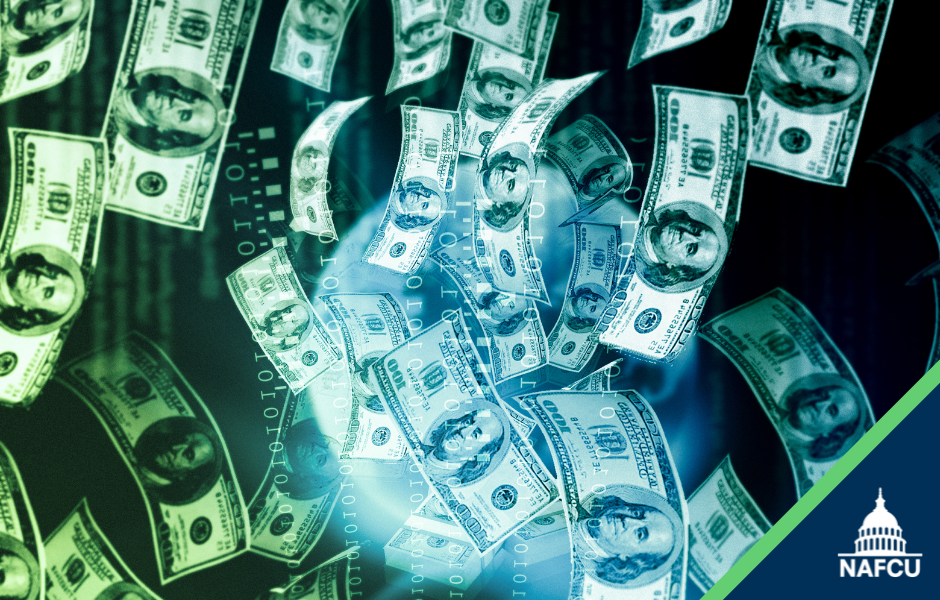Newsroom
The latest on instant payments, FedNow
 With the FedNow Service underway, there are several resources for credit unions to better understand the platform and payments innovations. According to Federal Reserve research released in May, strong majorities of businesses (83 percent) and consumers (75 percent) are already using faster payments, and most say they are likely to use faster payments more often in the future.
With the FedNow Service underway, there are several resources for credit unions to better understand the platform and payments innovations. According to Federal Reserve research released in May, strong majorities of businesses (83 percent) and consumers (75 percent) are already using faster payments, and most say they are likely to use faster payments more often in the future.
Tomorrow, NAFCU is hosting a complimentary webinar to demonstrate the Federal Reserve’s FedNow Service and discuss key considerations for onboarding to the service at 2 p.m. Eastern. Senior Vice President of FedNow Product Management Dan Baum will host the webinar.
In addition, the Federal Reserve is hosting a FedNow Town Hall Webinar Aug. 31. During the 90-minute event, attendees will hear from financial institutions that are live on FedNow about their launch experiences and use cases within instant payments. Registration is available online.
As demand continues to grow, here are four things that are important to know for financial institutions just getting started on the instant payments journey:
- What’s trending around the world. Instant payments, along with other types of faster payments, are quickly growing in popularity around the world and gaining momentum in the United States. According to PYMNTS latest Real-Time Payments World Map from 2023, 79 countries now have at least one real-time payments, compared to just 14 countries eight years ago. See highlights of faster payment trends in India, China, Europe, the U.K. and more.
- How faster/instant payments work. When it comes to instant payments, the end-user process may seem simple: User number one sends a payment and, moments later, user number two is notified that they’ve just received the payment. That’s simple enough, but the behind-the-scenes process can vary and feature different risks and benefits. To better understand the faster payments process, take a look at this hypothetical payment.
- The differences between fast, faster and instant payments. Many people use the terms “fast,” “faster,” “real time” and “instant payments” interchangeably. To consumers, faster and instant payment systems may seem similar, but things aren’t as similar behind the scenes. Faster payment systems can differ in several ways, including how clearing and settlement occur between financial institutions. These differences may affect how financial institutions design the services offered.
- Fraud and instant payments. There’s a lot to love about instant payments, but as with any type of payment, the potential for fraud exists. In general, the actions financial institutions, consumers and businesses take to minimize fraud with other payment types are also applicable for instant payments. However, due to their speed and irrevocability, instant payments require some unique considerations. Financial institutions thinking about instant payments adoption should consider taking a holistic approach to fraud prevention, particularly in cases where existing fraud solutions and processes may be based on batch processing or manual intervention. Learn more.
For more information on instant payments, visit FedNowExplorer.org.
Share This
Related Resources
Add to Calendar 2024-06-26 14:00:00 2024-06-26 14:00:00 Gallagher Executive Compensation and Benefits Survey About the Webinar The webinar will share trends in executive pay increases, annual bonuses, and nonqualified benefit plans. Learn how to use the data charts as well as make this data actionable in order to improve your retention strategy. You’ll hear directly from the survey project manager on how to maximize the data points to gain a competitive edge in the market. Key findings on: Total compensation by asset size Nonqualified benefit plans Bonus targets and metrics Prerequisites Demographics Board expenses Watch On-Demand Web NAFCU digital@nafcu.org America/New_York public
Gallagher Executive Compensation and Benefits Survey
preferred partner
Gallagher
Webinar
Add to Calendar 2024-06-21 09:00:00 2024-06-21 09:00:00 2024 Mid-Year Fraud Review Listen On: Key Takeaways: [01:16] Check fraud continues to be rampant across the country. Card fraud is affecting everyone. [04:31] Counterfeit US passport cards are just another new toolbox in the bad actors’ toolbox. [07:21] Blocking the fallback is the only way to defeat counterfeit cards. [11:17] The best way is constant education to your members in as many channels as you can. [13:02] We are still seeing overdraft lawsuits. Make sure the programming you have at your credit union matches what you have displayed for the members. Web NAFCU digital@nafcu.org America/New_York public
2024 Mid-Year Fraud Review
Strategy & Growth, Consumer Lending
preferred partner
Allied Solutions
Podcast
Add to Calendar 2024-06-21 09:00:00 2024-06-21 09:00:00 The Evolving Role of the CISO in Credit Unions Listen On: Key Takeaways: [01:30] Being able to properly implement risk management decisions, especially in the cyber age we live in, is incredibly important so CISOs have a lot of challenges here. [02:27] Having a leader who can really communicate cyber risks and understand how ready that institution is to deal with cyber events is incredibly important. [05:36] We need to be talking about risk openly. We need to be documenting and really understanding what remediating risk looks like and how you do that strategically. [16:38] Governance, risk, compliance, and adherence to regulatory controls are all being looked at much more closely. You are also seeing other technology that is coming into the fold directly responsible for helping CISOs navigate those waters. [18:28] The reaction from the governing bodies is directly related to the needs of the position. They’re trying to help make sure that we are positioned in a way that gets us the most possibility of success, maturing our postures and protecting the institutions. Web NAFCU digital@nafcu.org America/New_York public
The Evolving Role of the CISO in Credit Unions
preferred partner
DefenseStorm
Podcast
Get daily updates.
Subscribe to NAFCU today.
